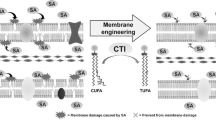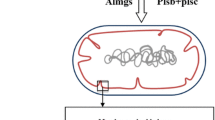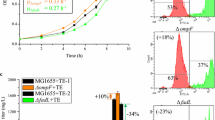Abstract
Menaquinone (MK) was an attractive membrane-bound intracellular chemical. To enhance its production, we tried to find the relationship between its synthesis and the state of cell membrane in producing strain. Due to non-ionic surfactant-polyoxyethylene oleyl ether (POE) and plant oil-cedar wood oil (CWO) can typically increase extracellular secretion and intracellular synthesis of MK respectively, the effect of these two substances on cell morphology, physical properties of cell membrane was investigated. Finally, two engineering strains were constructed to verify whether the state of cell membrane can enhance MK synthesis. The result showed that the edge of cells was broken when POE added in the medium. Other physical properties such as total fatty acid content decreased by 40.7% and the ratio of saturated fatty acids to unsaturated fatty acids decreased from 1.58 ± 0.05 to 1.31 ± 0.04. Meanwhile, cell membrane leakage was enhanced from 7.14 to 64.31%. Different from POE group, cell membrane was intact in CWO group. Moreover, the ratio of saturated fatty acids to unsaturated fatty acids increased from 1.58 ± 0.05 to 1.78 ± 0.04 and the average lipid length decreased from 16.05 ± 0.08 to 15.99 ± 0.10. Two constructed strains, especially Escherichia coli DH5α FatB, exhibited strong MK secretion ability and the extracellular MK reached 10.71 ± 0.19 mg/L. An understanding of these functionary mechanisms could not only provide a new idea for the synthesis of MK, but also provide a reference to increase the yield of intracellular membrane-bound metabolites.






Similar content being viewed by others
References
Bhalerao S, Clandinin TR (2012) Vitamin K2 takes charge. Science 336:1241–1242
Bligh EG, Dyer WJ (1959) A rapid method of total lipid extraction and purification. Can J Biochem Physiol 37:911–917
Desbois A, Smith V (2010) Antibacterial free fatty acids: activities, mechanisms of action and biotechnological potential. Appl Microbiol Biotechnol 85(6):1629–1642
Di PR, Betts G, Hoskins N, Edwards M, Ercolini D, Mauriello G (2007) Membrane toxicity of antimicrobial compounds from essential oils. J Agric Food Chem 55(12):4863–4870
Engelman DM (2005) Membranes are more mosaic than fluid. Nature 438:578–580
Epand RM, Epand RF (2009) Lipid domains in bacterial membranes and the action of antimicrobial agents. Biochim Biophys Acta Biomembr 1788(1):289–294
Grac M¸ Silveira AD, Romão MVS, Loureiro-Dias MC, Rombouts FM, Abee T (2002) Flow cytometric assessment of membrane integrity of ethanol-stressed Oenococcus oeni cells. Appl Environ Microbiol 68(12):6087–6093
Hartmann DO, Shimizu K, Siopa F, Leitão CM, Afonso CAM, Lopes JNC, Pereira CS (2015) Plasma membrane permeabilisation by ionic liquids: a matter of charge. Green Chem 17:4587–4598
Hiratsuka T, Furihata K, Ishikawa J, Yamashita H, Itoh N, Seto H, Dairi T (2008) An alternative menaquinone biosynthetic pathway operating in microorganisms. Science 321:1670–1673
Hisataka T, Takashi S, Yoshiki T (1995) Selective release of menaquinone-4 from cells of a mutant of Flavobacterium sp. 238-7 with a detergent. Biosci Biotech Biochem 59(6):1137–1138
Ishida Y (2008) Vitamin K2. Clin Calcium 18:1476–1482
Jacques NA, Jacques VL, Wolf AC, Wittenberger CL (1985) Does an increase in membrane unsaturated fatty acids account for Tween 80 stimulation of glucosyltransferase secretion by Streptococcus salivarius? J Gen Microbiol 131:67–72
Kong MK, Lee PC (2011) Metabolic engineering of menaquinone-8 pathway of Escherichia coli as a microbial platform for vitamin K production. Biotechnol Bioeng 108:1997–2002
Lennen RM, Pfleger BF (2013) Modulating membrane composition alters free fatty acid tolerance in Escherichia coli. PLoS ONE 8(1):1–10
Lennen RM, Kruziki MA, Kumar K, Zinkel RA, Burnum KE, Lipton MS, Hoover SW, Ranatunga DR, Wittkopp TM, Marner WD II, Pfleger BF (2011) Membrane stresses induced by overproduction of free fatty acids in Escherichia coli. Appl Environ Microbiol 77(22):8114–8128
Liu Y, Zheng ZM, Qiu HW, Zhao GH, Liu H, Li ZM, Wu HF, Tan M (2014) Surfactant supplementation to enhance the production of vitamin K2 metabolites in shake flask cultures using Escherichia. sp mutant FM3-1709. Food Technol Biotechnol 52(3):269–275
Liu Y, Wang L, Zheng ZM, Qiu HW, Wang P, Zhao GH, Gong GH, Song JY, Dai J (2015) Vitamin K2 production using Escherichia. sp mutant obtained by ion beam implantation induction. Plasma Sci Technol 17:159–166
Liu Y, Xue ZL, Chen SP, Wang Z, Zhang Y, Gong WL, Zheng ZM (2016) A high-throughput screening strategy for accurate quantification of menaquinone based on fluorescence-activated cell sorting. J Ind Microbiol Biotechnol 43:751–760
Nakagawa K, Hirota Y, Sawada N, Yuge N, Watanabe M, Uchino Y, Okuda N, Shimomura Y, Suhara Y, Okano T (2010) Identification of UBIAD1 as a novel human menaquinone-4 biosynthetic enzyme. Nature 468:117–122
Royce LA, Liu P, Stebbins MJ, Hanson BC, Jarboe LR (2013) The damaging effects of short chain fatty acids on Escherichia coli membranes. Appl Microbiol Biotechnol 97:8317–8327
Scheiber D, Veulemans V, Horn P, Chatrou ML, Potthoff SA, Kelm M, Schurgers LJ, Westenfeld R (2015) High-dose menaquinone-7 supplementation reduces cardiovascular calcification in a murine model of extraosseous calcification. Nutrients 7(8):6991–7011
Serrano-Vega MJ, Garces R, Martinez-Force E (2005) Cloning, characterization and structural model of a FatA-type thioesterase from sunflower seeds (Helianthus annuus L.). Planta 221:868–880
Suvarna K, Stevenson D, Meganathan R, Hudspeth MES (1998) Menaquinone (vitamin K2) biosynthesis: localization and characterization of the menA Gene from Escherichia coli. J Bacteriol 180(10):2782–2787
Taguchi H, Kita S, Tani Y (1991) Enzymatic alteration in the shikimate pathway during derivation of menaquinone-4-producing mutants of Flavobacterium sp. 238–7. Agric Biol Chem 55:769–773
Tvrzická E, Vecka M, Stanková B, Zak A (2002) Analysis of fatty acids in plasma lipoproteins by gas chromatography-flame ionization detection: quantitative aspects. Anal Chim Acta 465:337–350
Veld GI, Driessen AJM, Op den Kamp JAF, Konings WN (1991) Hydrophobic membrane thickness and lipid–protein interactions of the leucine transport system of Lactococcus lactis. Biochim Biophys Acta Biomembr 1065(2):203–212
Vitrac H, Bogdanov M, Dowhan W (2013) Proper fatty acid composition rather than an ionizable lipid amine is required for full transport function of lactose permease from Escherichia coli. J Biol Chem 288(8):5873–5885
Voelker TA, Davies HM (1994) Alteration of the specificity and regulation of fatty acid synthesis of Escherichia coli by expression of a plant medium-chain acyl-acyl carrier protein thioesterase. J Bacteriol 176:7320–7327
Yoshida H, Kotani Y, Ochiai K, Araki K (1998) Production of ubiquinone-10 using bacteria. J Gen Appl Microbiol 44:19–26
Yoshiki T, Hisataka T (1988) Excretion of menaquinone-4 by a mutant of Flavobacterium sp. 238-7 in a detergent- supplemented culture. Agric Biol Chem 52(2):449–454
Yoshiki T, Hisataka T (1989) Extracellular production of menaquinone-4 by a mutant of flavobacterium sp. 238-7 with a detergent-supplemented culture. J Ferment Bioeng 67(2):102–106
Acknowledgements
The study was supported by the National Nature Science Foundation of China (No. 31501465, 31471615), the National High-tech R&D Program (No. 2014AA021704), Anhui Provincial Nature Science Foundation (No. 1608085QC54), Anhui Higher Education Exchange Program for Young Talents (No. gxfxZD2016109) and Anhui Provincial Undergraduate Innovation and Entrepreneurship Program (No.201510363130) and the National Undergraduate Innovation and Entrepreneurship Program (No. 2016103630055).
Author information
Authors and Affiliations
Corresponding authors
Rights and permissions
About this article
Cite this article
Liu, Y., Ding, Xm., Xue, Zl. et al. The change of the state of cell membrane can enhance the synthesis of menaquinone in Escherichia coli . World J Microbiol Biotechnol 33, 52 (2017). https://doi.org/10.1007/s11274-017-2222-9
Received:
Accepted:
Published:
DOI: https://doi.org/10.1007/s11274-017-2222-9




